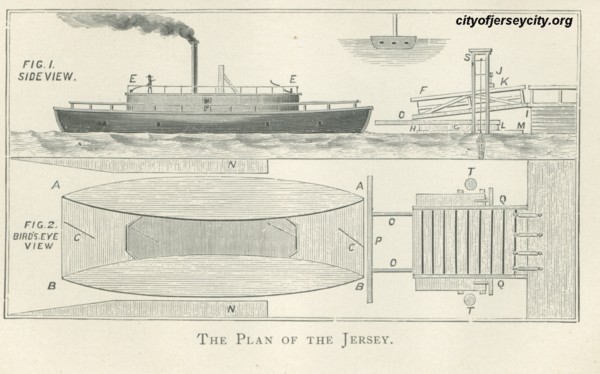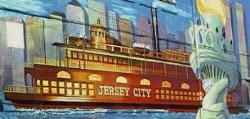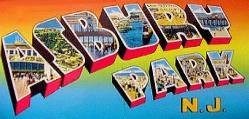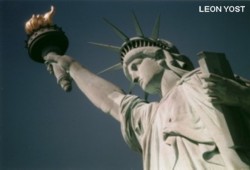 |  |  |
|
| ||
 |  |  |
 |  |  |
|
| ||
 |  |  |
|
|
By Harriet Phillips Eaton
Published 1899
This Web version, edited by GET NJ
COPYRIGHT 2002
In 1805 the Associates built a new tavern of brick, known as the Hudson House. It is still standing on Grand near Hudson street, and is part of the Colgate Soap works. Between this hotel and the ferry landing was a semi-circular plot around which the stages would run to unload their passengers. In the center of this plot was a willow tree which was sometimes used as a whipping post. Winfield tells that as late as 1814 a white-headed old man here received thirty-two lashes. The newspapers of the day advertised over twenty daily stage lines, besides the irregular stages, communicating with all parts of the state, and farmers wagons, even from Pennsylvania, brought produce to New York by way of this ferry. Horses and wagons were lifted on to the sail boats, but the ferriage was so expensive that in general the produce and freight was put upon the boats and the teams and wagons left in the stables of the Hudson House. The ferry site has been frequently changed. Its second removal was to the foot of York street. On April 1st, 1839, it was changed to the corner of Montgomery and Hudson streets. In 1856 the block east of Hudson street was filled in and the landing was changed to its present location.
In the fall of 1809 several Newark gentlemen subscribed $50,000 to start steam ferryboats, and Fulton was asked to construct such a boat as he would consider suitable for the purpose. In March, 1811, they obtained the lease of the ferry and, the right of landing on the New York side. Two boats were built by Charles Brown, a noted ship-builder of New York, who had built the Clermont in 1807 for Fulton, and whose ship-yard was on East river near Fourth and Sixth streets. They were eighty feet in length and thirty feet in width. The boats were named the Jersey and the York. The Jersey was the first boat finished and began her regular trips on July 17th, 1812. A passenger on its first day wrote to the Centinel of Freedom:
I give Fulton's description of the boats as quoted by Winfield in his History of Hudson County:
The dock is one hundred and eighty feet long and seventy feet wide, the bridge is fastened to the middle of the bulkhead. `The boat being only thirty feet wide and the dock seventy, leaves twenty feet vacant on each of her sides; in each of these twenty feet spans and in the water are floating stages, made of pine logs, which lie favorably to the boat for thirty feet, and these run diagonally to the extreme end of the wharves, so that the boat when coming in hits within the seventy feet and the stages guide her direct to the bridge.

In 1813 the York, built on the model of the Jersey, was completed and placed on the ferry. It is said that "they ordinarily took an hour and a half to make a trip." They started at sunrise from each side of the river and ran all day, every half hour, by "St. Paul's Church lock." The fares were collected on the boat during the passage over. The Jersey was in service for many years and finally being condemned, was broken up and sold to Mr. Isaac Edge, who built a stable from its planks and beams. From a portion of this wood two canes were made, which are still treasured in the Edge family.
The Ferry Company had a very unfortunate experience; they sank all of their capital and in 1824 were obliged to assign their lease to Francis B. Ogden, Cadawalder D. Colden, and Samuel Swartout, who secured a new lease for fifteen years and six months from November 1st, 1825. They were to provide two good steamboats, but were afterwards permitted to use a team-boat in place of one. They were also to provide rowboats. They bought and placed on the ferry the Washington. Within a year Messrs. Ogden and Swartout transferred their interest to Mr. Colden; he failed to make it remunerative and surrendered the lease to the owners, "the Associates of the Jersey Company." January 1st, 1831, they leased it to the New Jersey Railroad and Transportation Company. By renewals the lease was continued until 1853, when the Railroad bought up the stock of the Associates and became the owners of the ferry. The first night boat was put on in June, 1835. The line to the foot of Desbrosses street was started in 1862. These ferries were transferred to the Pennsylvania Railroad Company in 1871. Among the various schemes to secure patronage for the ferry by bringing people from New York, was the erection in 1825 of a large amphitheatre on the south side of Sussex street, between Hudson and Green streets, on land leased from Mr. Drayton, Sr. For about two months large numbers, mostly from New York, gathered here on Fridays to witness the fighting of bulls, bears, buffaloes and dogs.
|
|
|
|
 Your Ancestors' Story |
 Bruce Springsteen's Jersey Shore Rock Haven! |

|
UrbanTimes.com |